-
 Liquid Argon time projection chambers offer an unparalleled level of detail in neutrino interactions. Photo by Corey Adams
Liquid Argon time projection chambers offer an unparalleled level of detail in neutrino interactions. Photo by Corey Adams -
 Fall Foliage in Branford, CT (Fall 2012). Photo by Richard Casten
Fall Foliage in Branford, CT (Fall 2012). Photo by Richard Casten -
![Confocal image of two adherent basal-layer skin cells (keratinocytes) from a mouse, of which Aaron F. Mertz (Physics Ph.D. '13) and colleagues have measured traction forces to demonstrate that small colonies of epithelial cells behave mechanically similarly to liquid droplets on soft substrates [green marks the cytoskeleton (phalloidin), blue marks focal adhesions (zyxin), and red marks the intercellular adhesion (E-cadherin)]. See Mertz et al. Physical Review Letters 108, 198101 (2012). Photo by Aaron Mertz (3rd Place)](https://physics.yale.edu/sites/default/files/styles/adaptive/adaptive-image/public/img006_0.jpg?itok=WuMjUYwP) Confocal image of two adherent basal-layer skin cells (keratinocytes) from a mouse, of which Aaron F. Mertz (Physics Ph.D. '13) and colleagues have measured traction forces to demonstrate that small colonies of epithelial cells behave mechanically similarly to liquid droplets on soft substrates [green marks the cytoskeleton (phalloidin), blue marks focal adhesions (zyxin), and red marks the intercellular adhesion (E-cadherin)]. See Mertz et al. Physical Review Letters 108, 198101 (2012). Photo by Aaron Mertz (3rd Place)
Confocal image of two adherent basal-layer skin cells (keratinocytes) from a mouse, of which Aaron F. Mertz (Physics Ph.D. '13) and colleagues have measured traction forces to demonstrate that small colonies of epithelial cells behave mechanically similarly to liquid droplets on soft substrates [green marks the cytoskeleton (phalloidin), blue marks focal adhesions (zyxin), and red marks the intercellular adhesion (E-cadherin)]. See Mertz et al. Physical Review Letters 108, 198101 (2012). Photo by Aaron Mertz (3rd Place) -
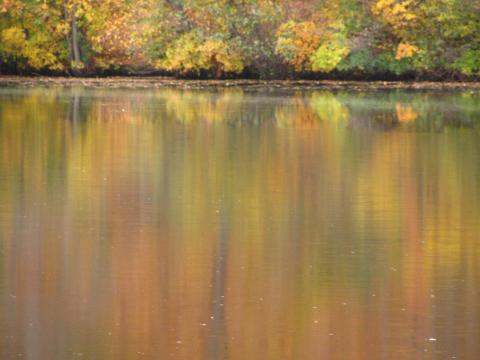 Fall Foliage in Branford, CT (Fall 2012). Photo by Richard Casten
Fall Foliage in Branford, CT (Fall 2012). Photo by Richard Casten -
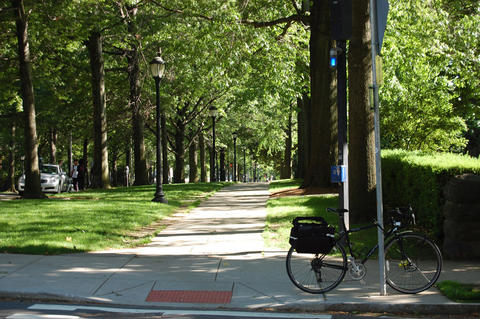 The most beautiful street in America, C. Dickens and M. Twain (Hillhouse Avenue). Photo by Claudia De Grandi (1st Place)
The most beautiful street in America, C. Dickens and M. Twain (Hillhouse Avenue). Photo by Claudia De Grandi (1st Place) -
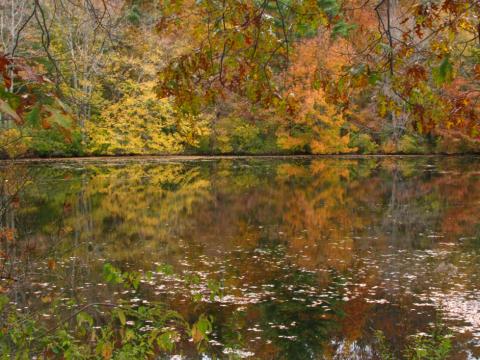 Fall Foliage in Branford, CT (Fall 2012). Photo by Richard Casten
Fall Foliage in Branford, CT (Fall 2012). Photo by Richard Casten -
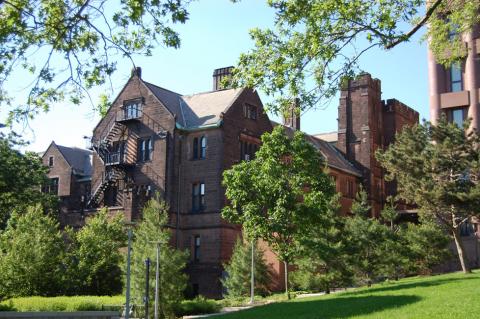 Sloane Physics Laboratory on Science Hill. Photo by Claudia De Grandi
Sloane Physics Laboratory on Science Hill. Photo by Claudia De Grandi -
 Fall Foliage in Branford, CT (Fall 2012). Photo by Richard Casten
Fall Foliage in Branford, CT (Fall 2012). Photo by Richard Casten -
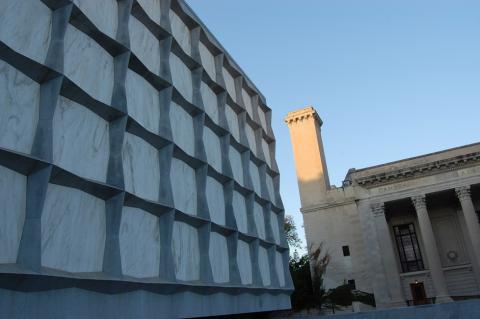 Beinecke library. Photo by Claudia De Grandi
Beinecke library. Photo by Claudia De Grandi -
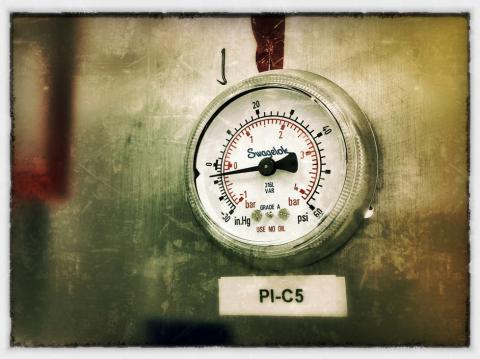 Taken at Sanford Underground Laboratory in Lead, SD. Photo by Blair Edwards
Taken at Sanford Underground Laboratory in Lead, SD. Photo by Blair Edwards -
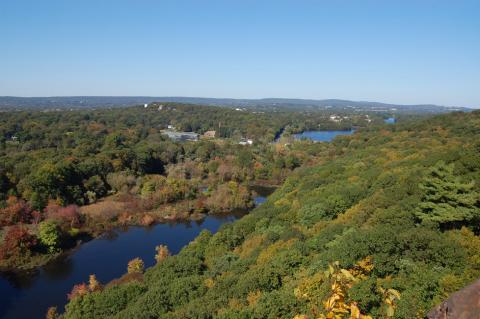 Views of Connecticut landscape from East Rock. Photo by Claudia De Grandi
Views of Connecticut landscape from East Rock. Photo by Claudia De Grandi -
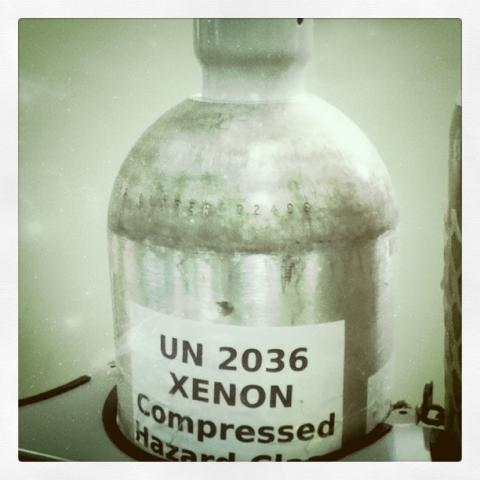 Taken at Sanford Underground Laboratory in Lead, SD. Photo by Blair Edwards
Taken at Sanford Underground Laboratory in Lead, SD. Photo by Blair Edwards -
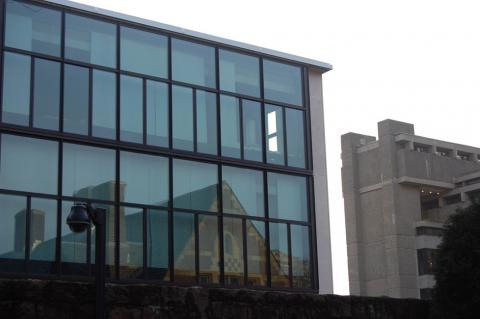 To live and make nothing is intolerable. The dream has in it already the will to be and the desire to express this will. Luis Kahn (Yale Art Gallery). Photo by Claudia De Grandi
To live and make nothing is intolerable. The dream has in it already the will to be and the desire to express this will. Luis Kahn (Yale Art Gallery). Photo by Claudia De Grandi -
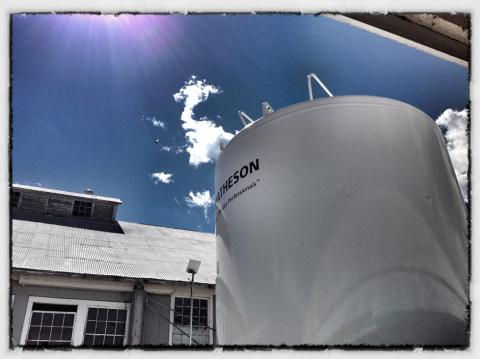 Taken at Sanford Underground Laboratory in Lead, SD. Photo by Blair Edwards
Taken at Sanford Underground Laboratory in Lead, SD. Photo by Blair Edwards -
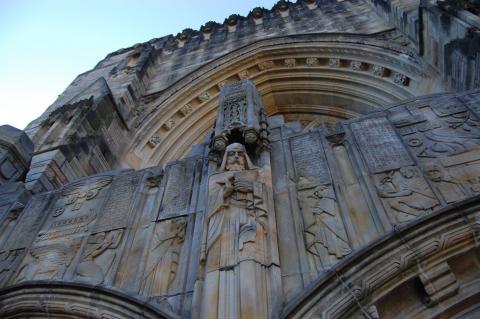 The library is the Heart of the University ( Sterling Memorial Library). Photo by Claudia De Grandi
The library is the Heart of the University ( Sterling Memorial Library). Photo by Claudia De Grandi -
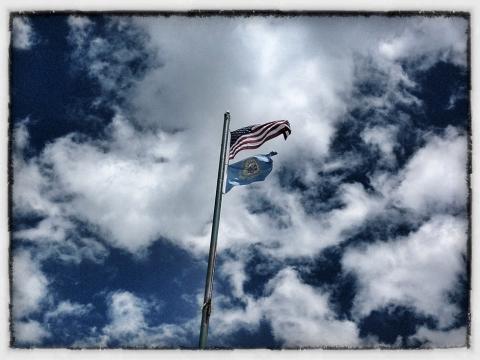 Taken at Sanford Underground Laboratory in Lead, SD. Photo by Blair Edwards
Taken at Sanford Underground Laboratory in Lead, SD. Photo by Blair Edwards -
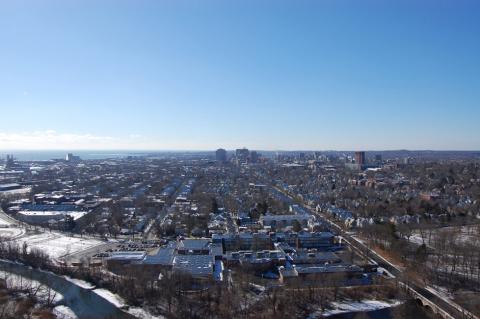 January: view of New Haven from the top of the East Rock. Photo by Claudia De Grandi
January: view of New Haven from the top of the East Rock. Photo by Claudia De Grandi -
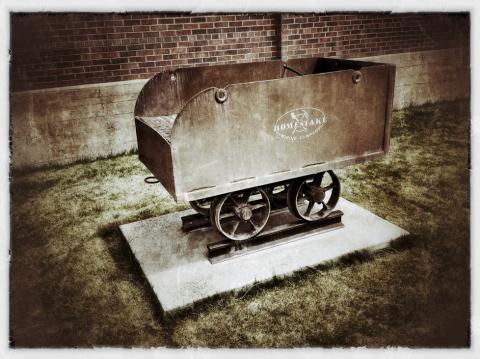 Taken at Sanford Underground Laboratory in Lead, SD. Photo by Blair Edwards
Taken at Sanford Underground Laboratory in Lead, SD. Photo by Blair Edwards -
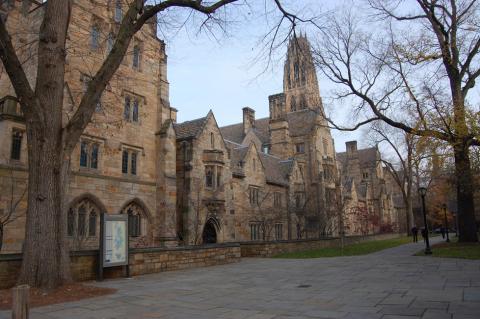 Yale campus: Library walk. Photo by Claudia De Grandi
Yale campus: Library walk. Photo by Claudia De Grandi -
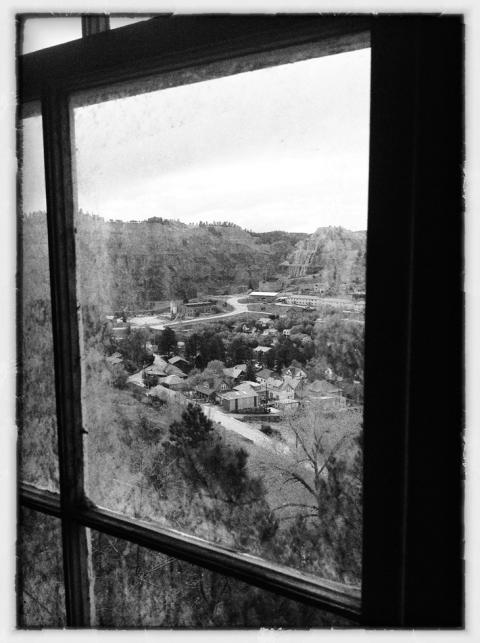 Taken at Sanford Underground Laboratory in Lead, SD. Photo by Blair Edwards
Taken at Sanford Underground Laboratory in Lead, SD. Photo by Blair Edwards -
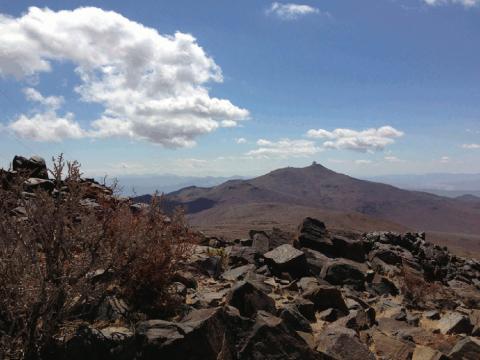 This is a picture I took from Chile last February, looking back at the domes at the European Southern Observatory at La Silla. I am about 5 miles away, on a nearby peak called "Viscacha Peak". THe observatory is on the edge of the Atacama desert in Northern Chile, one of the driest places in the world. This is the observatory where we operate the La Silla - QUEST survey for supernova and trans-Neptunian objects, headed by Prof. Baltay.. Photo by David Rabinowitz
This is a picture I took from Chile last February, looking back at the domes at the European Southern Observatory at La Silla. I am about 5 miles away, on a nearby peak called "Viscacha Peak". THe observatory is on the edge of the Atacama desert in Northern Chile, one of the driest places in the world. This is the observatory where we operate the La Silla - QUEST survey for supernova and trans-Neptunian objects, headed by Prof. Baltay.. Photo by David Rabinowitz -
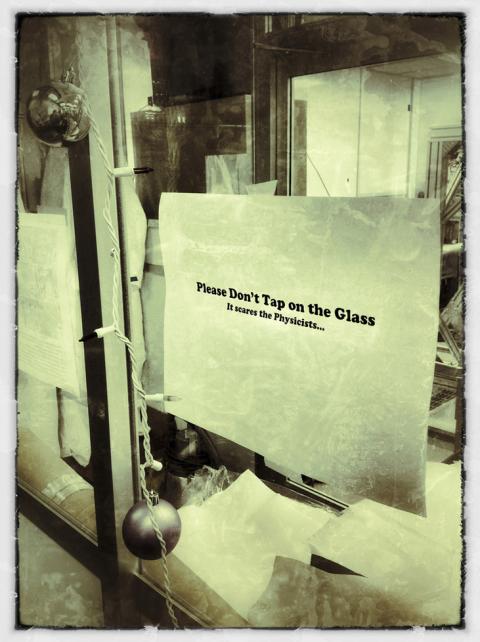 Taken at Sanford Underground Laboratory in Lead, SD. Photo by Blair Edwards
Taken at Sanford Underground Laboratory in Lead, SD. Photo by Blair Edwards -
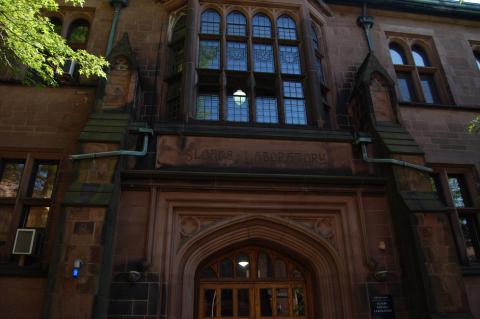 Intimidating entrance of the Sloane Physics Laboratory. Photo by Claudia De Grandi
Intimidating entrance of the Sloane Physics Laboratory. Photo by Claudia De Grandi -
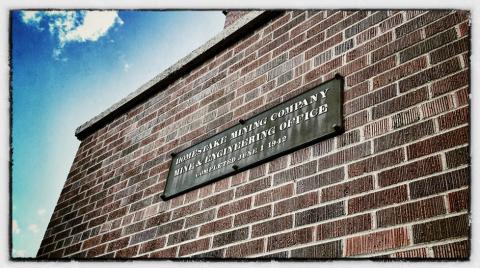 Taken at Sanford Underground Laboratory in Lead, SD. Photo by Blair Edwards
Taken at Sanford Underground Laboratory in Lead, SD. Photo by Blair Edwards -
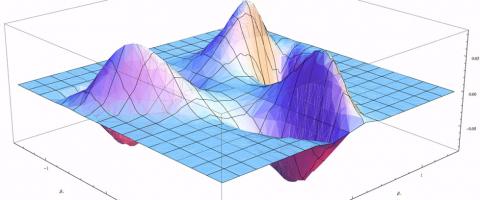 Plot of Quantum Mixmaster Excitation State (2,1) in Minisuperspace. Photo by Joseph Bae
Plot of Quantum Mixmaster Excitation State (2,1) in Minisuperspace. Photo by Joseph Bae -
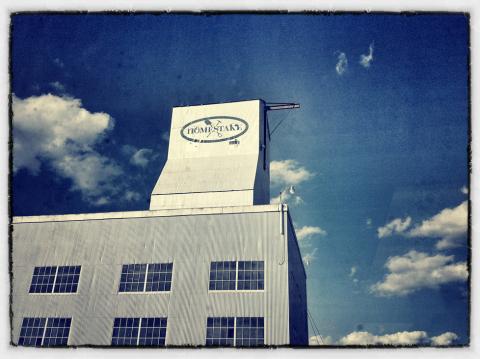 Taken at Sanford Underground Laboratory in Lead, SD. Photo by Blair Edwards
Taken at Sanford Underground Laboratory in Lead, SD. Photo by Blair Edwards -
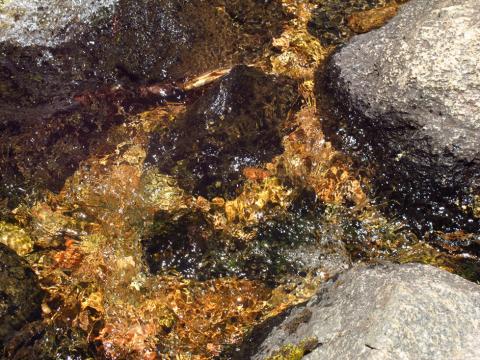 Flowing Water and colored rocks in a mountain stream (June 2013). Photo by Richard Casten
Flowing Water and colored rocks in a mountain stream (June 2013). Photo by Richard Casten -
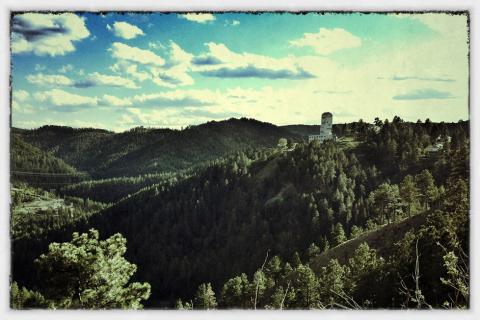 Taken at Sanford Underground Laboratory in Lead, SD. Photo by Blair Edwards
Taken at Sanford Underground Laboratory in Lead, SD. Photo by Blair Edwards -
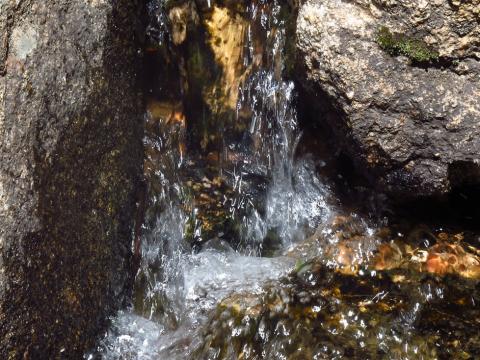 Flowing Water and colored rocks in a mountain stream (June 2013). Photo by Richard Casten
Flowing Water and colored rocks in a mountain stream (June 2013). Photo by Richard Casten -
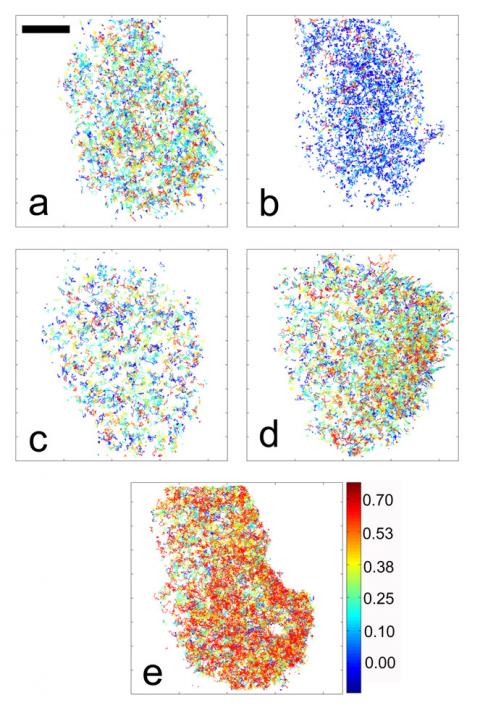 Particle tracks, each displayed in a color corresponding to the track diffusion coefficient superimposed on a white background, for individual cells expressing (a) RhoA, (b) RhoA G14V, (c) RhoA F30L, (d) RhoA T19N, and (e) RhoA HV in a MCF10A breast epithelial cell line. The black scale bar represents 10 um. Photo by Peter Koo
Particle tracks, each displayed in a color corresponding to the track diffusion coefficient superimposed on a white background, for individual cells expressing (a) RhoA, (b) RhoA G14V, (c) RhoA F30L, (d) RhoA T19N, and (e) RhoA HV in a MCF10A breast epithelial cell line. The black scale bar represents 10 um. Photo by Peter Koo -
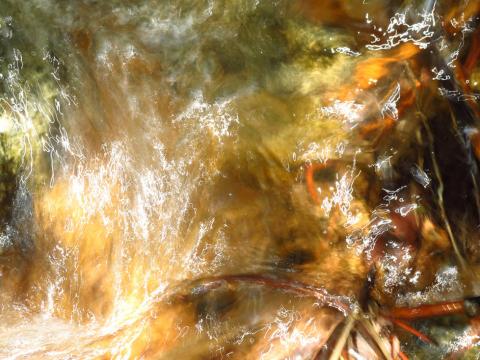 Flowing Water and colored rocks in a mountain stream (June 2013). Photo by Richard Casten
Flowing Water and colored rocks in a mountain stream (June 2013). Photo by Richard Casten -
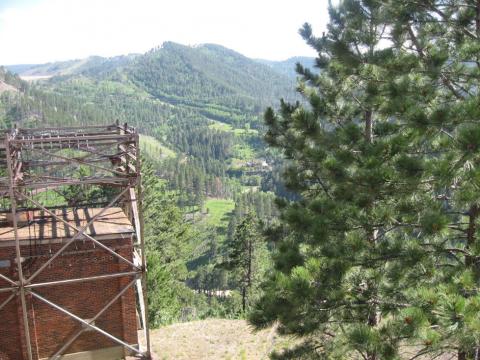 The Black Hills surrounding Homestake Mine are the home of the Large Underground Xenon (LUX) detector (McKinsey), a device searching for dark matter particles called "WIMPS". Photo by Ariana Hackenburg and Nichole Larsen
The Black Hills surrounding Homestake Mine are the home of the Large Underground Xenon (LUX) detector (McKinsey), a device searching for dark matter particles called "WIMPS". Photo by Ariana Hackenburg and Nichole Larsen -
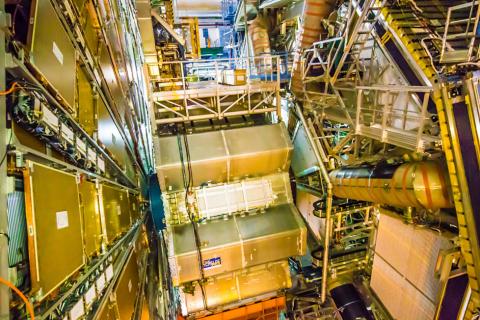 Toroid magnets and muon chambers: knowledge is priceless! Long Shutdown 1 is ongoing to prepare all the subdetectors for the full energy LHC operation. Photo by Andrey Loginov
Toroid magnets and muon chambers: knowledge is priceless! Long Shutdown 1 is ongoing to prepare all the subdetectors for the full energy LHC operation. Photo by Andrey Loginov -
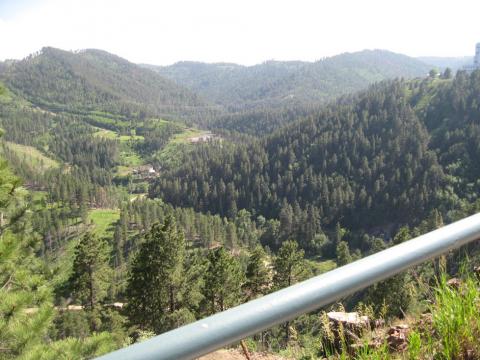 The Black Hills surrounding Homestake Mine are the home of the Large Underground Xenon (LUX) detector (McKinsey), a device searching for dark matter particles called "WIMPS". Photo by Ariana Hackenburg and Nichole Larsen
The Black Hills surrounding Homestake Mine are the home of the Large Underground Xenon (LUX) detector (McKinsey), a device searching for dark matter particles called "WIMPS". Photo by Ariana Hackenburg and Nichole Larsen -
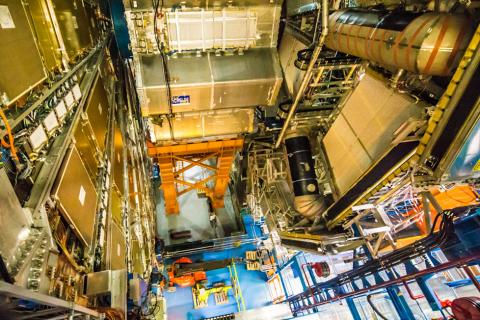 View from the top: it took many years to dig the cavern and build the detector; now ATLAS is digging deep into high energy physics. Photo by Andrey Loginov
View from the top: it took many years to dig the cavern and build the detector; now ATLAS is digging deep into high energy physics. Photo by Andrey Loginov -
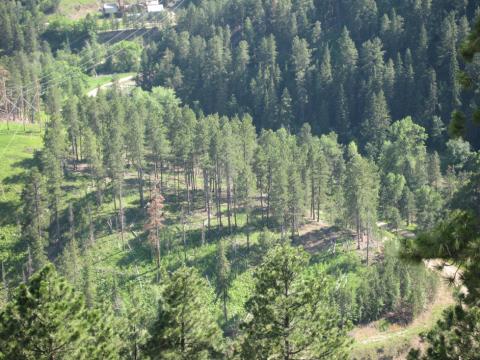 The Black Hills surrounding Homestake Mine are the home of the Large Underground Xenon (LUX) detector (McKinsey), a device searching for dark matter particles called "WIMPS". Photo by Ariana Hackenburg and Nichole Larsen
The Black Hills surrounding Homestake Mine are the home of the Large Underground Xenon (LUX) detector (McKinsey), a device searching for dark matter particles called "WIMPS". Photo by Ariana Hackenburg and Nichole Larsen -
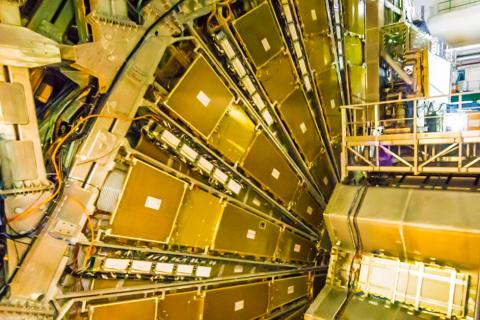 The future is bright: when the long shutdown is finished (by the end of 2014) LHC will be providing (and ATLAS will be taking) 14 TeV pp collisions data to further improve precision measurements as well as sensitivity to the physics beyond the Standard Model. Photo by Andrey Loginov
The future is bright: when the long shutdown is finished (by the end of 2014) LHC will be providing (and ATLAS will be taking) 14 TeV pp collisions data to further improve precision measurements as well as sensitivity to the physics beyond the Standard Model. Photo by Andrey Loginov -
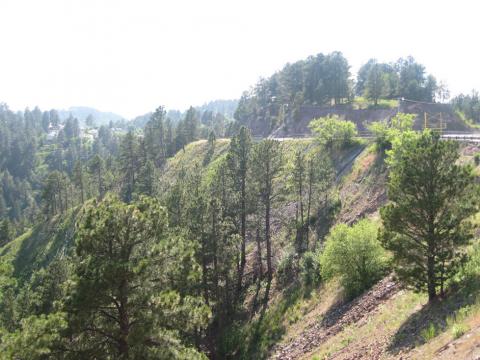 The Black Hills surrounding Homestake Mine are the home of the Large Underground Xenon (LUX) detector (McKinsey), a device searching for dark matter particles called "WIMPS". Photo by Ariana Hackenburg and Nichole Larsen
The Black Hills surrounding Homestake Mine are the home of the Large Underground Xenon (LUX) detector (McKinsey), a device searching for dark matter particles called "WIMPS". Photo by Ariana Hackenburg and Nichole Larsen -
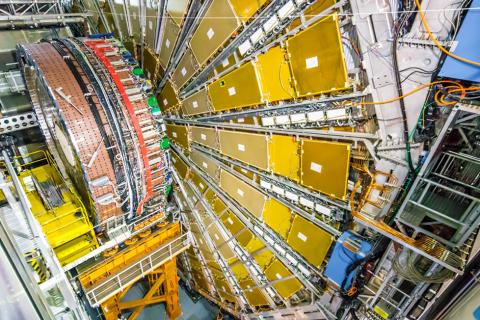 Checks, maintenance, improvements... Shutdown means more work to do so that there are more (good!) data to analyze when the LHC resumes operation at the highest energy ever. Photo by Andrey Loginov
Checks, maintenance, improvements... Shutdown means more work to do so that there are more (good!) data to analyze when the LHC resumes operation at the highest energy ever. Photo by Andrey Loginov -
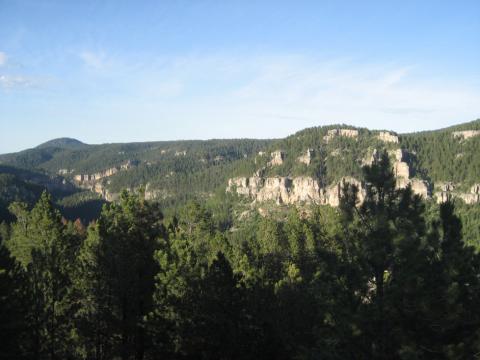 The Black Hills surrounding Homestake Mine are the home of the Large Underground Xenon (LUX) detector (McKinsey), a device searching for dark matter particles called "WIMPS". Photo by Ariana Hackenburg and Nichole Larsen
The Black Hills surrounding Homestake Mine are the home of the Large Underground Xenon (LUX) detector (McKinsey), a device searching for dark matter particles called "WIMPS". Photo by Ariana Hackenburg and Nichole Larsen -
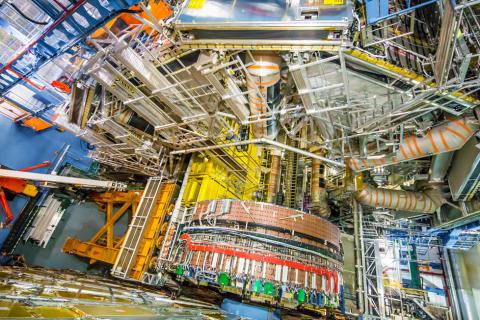 Checks, maintenance, improvements... Shutdown means more work to do so that there are more (good!) data to analyze when the LHC resumes operation at the highest energy ever. Photo by Andrey Loginov
Checks, maintenance, improvements... Shutdown means more work to do so that there are more (good!) data to analyze when the LHC resumes operation at the highest energy ever. Photo by Andrey Loginov -
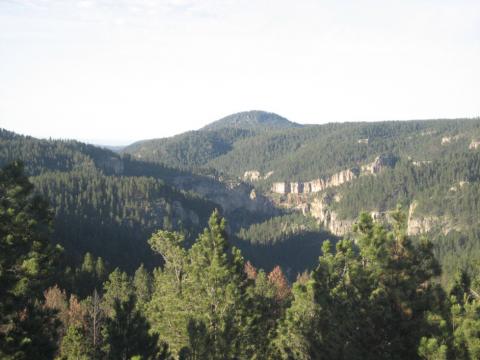 The Black Hills surrounding Homestake Mine are the home of the Large Underground Xenon (LUX) detector (McKinsey), a device searching for dark matter particles called "WIMPS". Photo by Ariana Hackenburg and Nichole Larsen
The Black Hills surrounding Homestake Mine are the home of the Large Underground Xenon (LUX) detector (McKinsey), a device searching for dark matter particles called "WIMPS". Photo by Ariana Hackenburg and Nichole Larsen -
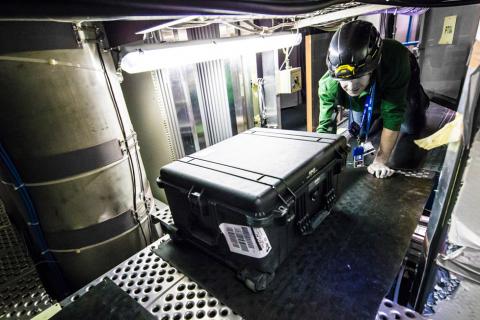 Bringing an endoscope to start checking for leaks in the ATLAS TRT active gas system. Photo by Andrey Loginov
Bringing an endoscope to start checking for leaks in the ATLAS TRT active gas system. Photo by Andrey Loginov -
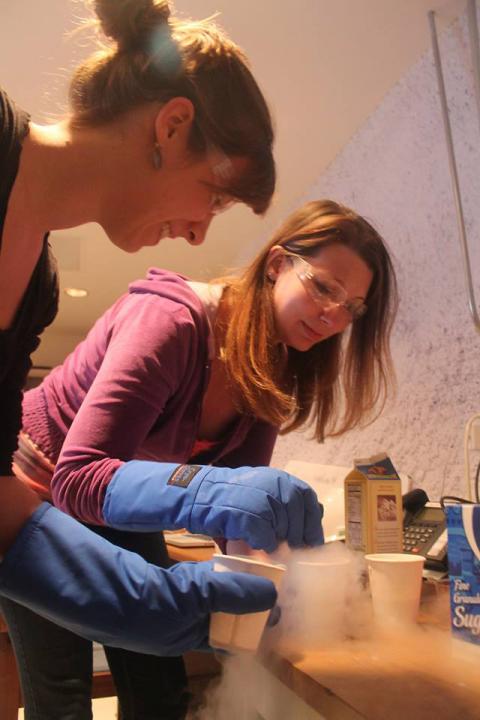 Homestake Mine houses more than just the LUX detector--it also plays host to several world-famous liquid nitrogen ice cream chefs. Photo by Ariana Hackenburg and Nichole Larsen
Homestake Mine houses more than just the LUX detector--it also plays host to several world-famous liquid nitrogen ice cream chefs. Photo by Ariana Hackenburg and Nichole Larsen -
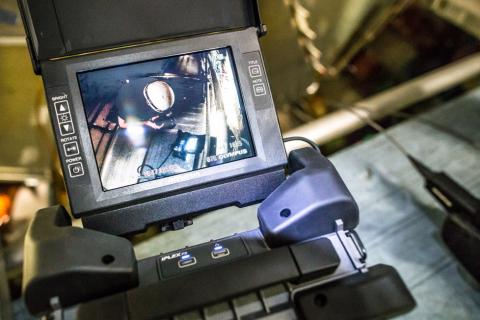 Taking a picture of the endoscope screen with the endoscope pointing at the photographer. In a couple of hours the endoscope helped to locate a few leaking tubes in the system. Photo by Andrey Loginov
Taking a picture of the endoscope screen with the endoscope pointing at the photographer. In a couple of hours the endoscope helped to locate a few leaking tubes in the system. Photo by Andrey Loginov -
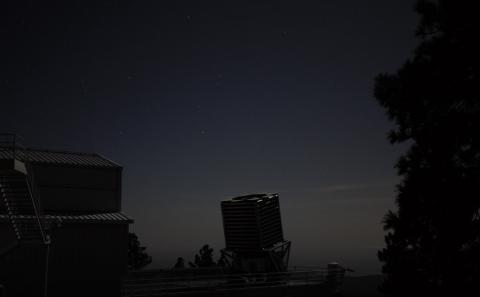 Nightly observations under a full moon, at the 2.5m Sloan Telescope at Apache Point, New Mexico. Yale is a member of the Sloan Digital Sky Survey. Photo by John Parejko
Nightly observations under a full moon, at the 2.5m Sloan Telescope at Apache Point, New Mexico. Yale is a member of the Sloan Digital Sky Survey. Photo by John Parejko -
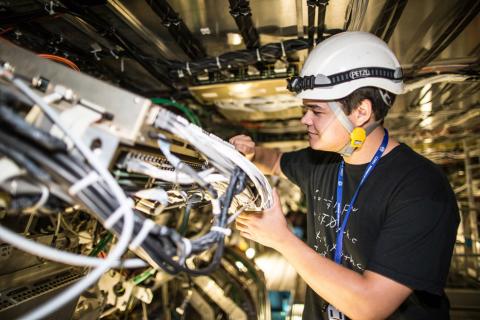 First visit to the ATLAS pit (and inside the ATLAS detector) of the first year graduate student Jared Vasquez (Prof.Tipton), who is being trained as a TRT data acquisition (DAQ) expert. Photo by Andrey Loginov
First visit to the ATLAS pit (and inside the ATLAS detector) of the first year graduate student Jared Vasquez (Prof.Tipton), who is being trained as a TRT data acquisition (DAQ) expert. Photo by Andrey Loginov -
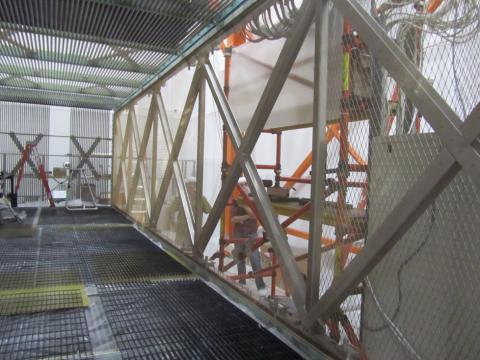 A view from inside the Time Projection Chamber being assembled at Fermilab. The golden haze are the wires, which will be used to collect the signal coming from neutrino interactions. A large part of the wire boards were made in WNSL at Yale. Photo by Andrzej Szelc
A view from inside the Time Projection Chamber being assembled at Fermilab. The golden haze are the wires, which will be used to collect the signal coming from neutrino interactions. A large part of the wire boards were made in WNSL at Yale. Photo by Andrzej Szelc -
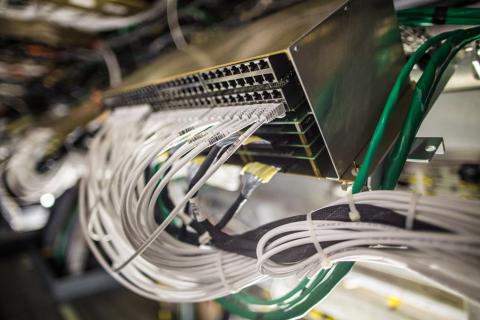 Information transfer from the ATLAS detector to the ground is a crucial part of the data taking. Photo by Andrey Loginov
Information transfer from the ATLAS detector to the ground is a crucial part of the data taking. Photo by Andrey Loginov -
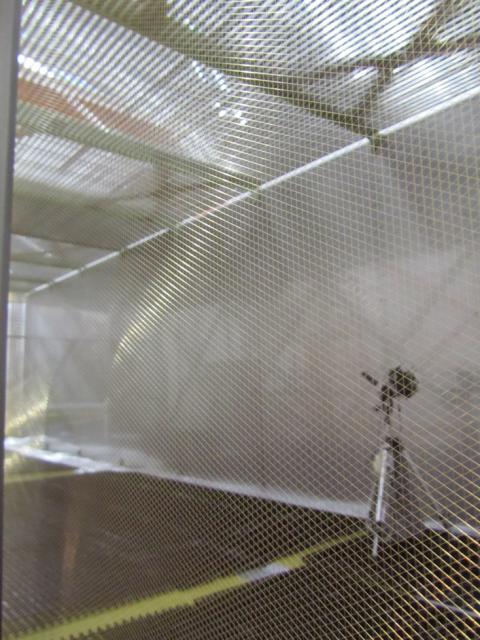 A view from the outside of the tpc where it's possible to see the three planes of wires that will allow reconstructing the tracks in 3D. Photo by Andrzej Szelc
A view from the outside of the tpc where it's possible to see the three planes of wires that will allow reconstructing the tracks in 3D. Photo by Andrzej Szelc -
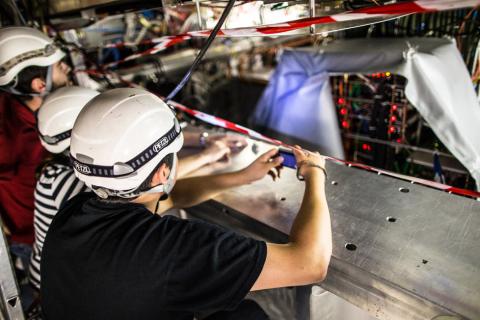 TRT DAQ experts train future DAQ experts (including those from Yale University) at a TRT electronics box (Patch Panel). Photo by Andrey Loginov
TRT DAQ experts train future DAQ experts (including those from Yale University) at a TRT electronics box (Patch Panel). Photo by Andrey Loginov -
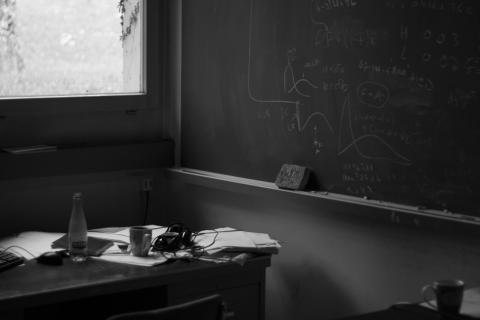 A Yale office at CERN - Meyrin, Switzerland. Photo by Lawrence Lee
A Yale office at CERN - Meyrin, Switzerland. Photo by Lawrence Lee -
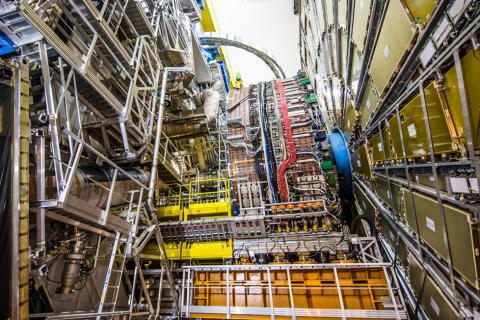 Scaffoldings are installed for easier access to various components of the muon system and the magnet system: a lot of work is ongoing. Photo by Andrey Loginov
Scaffoldings are installed for easier access to various components of the muon system and the magnet system: a lot of work is ongoing. Photo by Andrey Loginov -
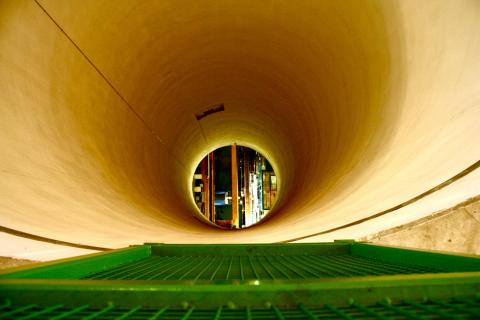 The ATLAS detector at the LHC at CERN from above - Meyrin, Switzerland. Photo by Lawrence Lee
The ATLAS detector at the LHC at CERN from above - Meyrin, Switzerland. Photo by Lawrence Lee -
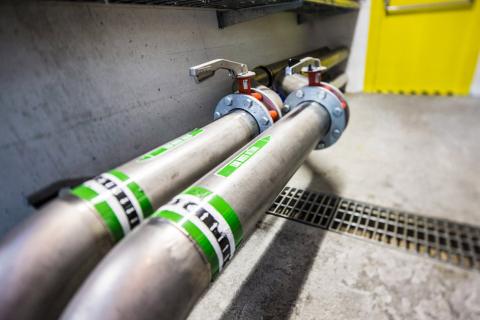 Water cooling input and output pipes: reliable cooling system is the necessity for the successful operation of the ATLAS detector. Photo by Andrey Loginov
Water cooling input and output pipes: reliable cooling system is the necessity for the successful operation of the ATLAS detector. Photo by Andrey Loginov -
 A view of the CERN globe from the sunflower fields - Meyrin, Switzerland. Photo by Lawrence Lee
A view of the CERN globe from the sunflower fields - Meyrin, Switzerland. Photo by Lawrence Lee -
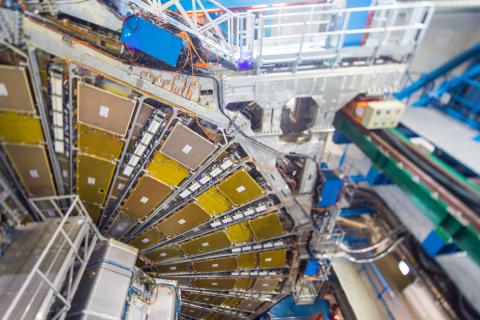 View from the very top of the ATLAS detector. At this level there are racks with low voltage power supplies for TRT on-detector electronics (so that's one of the views to see for TRT DAQ experts -- their job is real fun!). Photo by Andrey Loginov
View from the very top of the ATLAS detector. At this level there are racks with low voltage power supplies for TRT on-detector electronics (so that's one of the views to see for TRT DAQ experts -- their job is real fun!). Photo by Andrey Loginov -
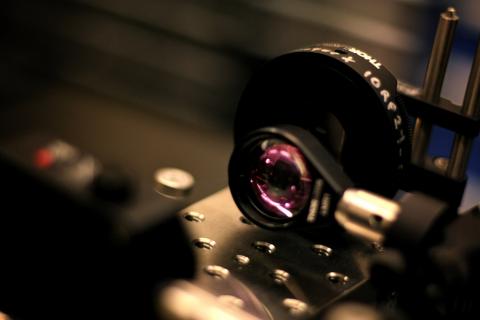 An optics table of Jack Harris' group - New Haven, CT. Photo by Lawrence Lee
An optics table of Jack Harris' group - New Haven, CT. Photo by Lawrence Lee -
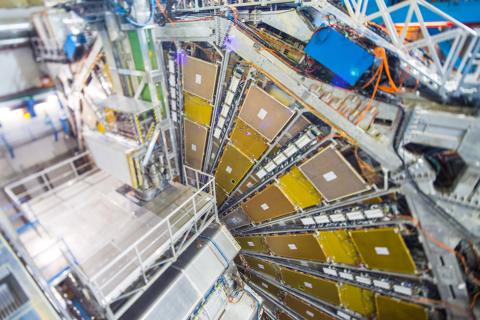 View from the very top of the ATLAS detector. At this level there are racks with low voltage power supplies for TRT on-detector electronics (so that's one of the views to see for TRT DAQ experts -- their job is real fun!). Photo by Andrey Loginov
View from the very top of the ATLAS detector. At this level there are racks with low voltage power supplies for TRT on-detector electronics (so that's one of the views to see for TRT DAQ experts -- their job is real fun!). Photo by Andrey Loginov -
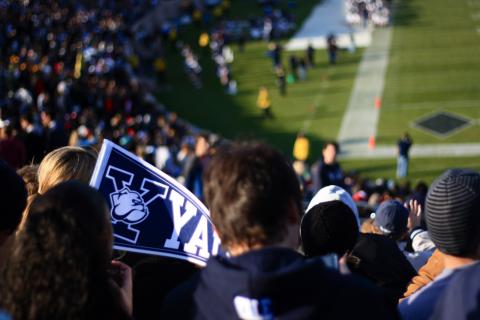 2009 Yale-Harvard game - New Haven, CT. Photo by Lawrence Lee
2009 Yale-Harvard game - New Haven, CT. Photo by Lawrence Lee -
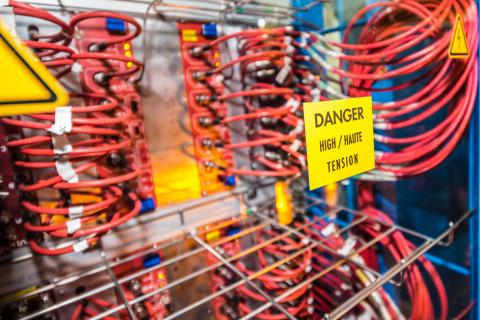 It's dangerous! (judging by the "Danger" sign and by the color of the cables). Photo by Andrey Loginov
It's dangerous! (judging by the "Danger" sign and by the color of the cables). Photo by Andrey Loginov -
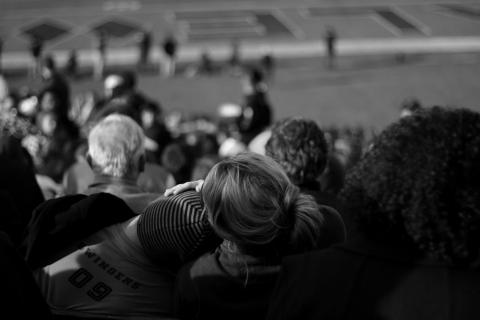 2009 Yale-Harvard game - New Haven, CT. Photo by Lawrence Lee
2009 Yale-Harvard game - New Haven, CT. Photo by Lawrence Lee -
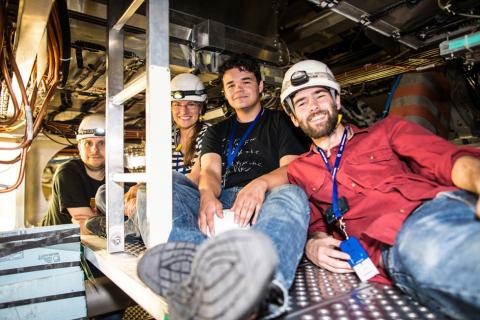 Inside the ATLAS detector (yes, one has to crawl inside to access various locations of off-detector TRT electronics): TRT data acquisition trainers and trainees (including Jared Vasquez from Yale Physics Department -- the one without the helmet). Photo by Andrey Loginov
Inside the ATLAS detector (yes, one has to crawl inside to access various locations of off-detector TRT electronics): TRT data acquisition trainers and trainees (including Jared Vasquez from Yale Physics Department -- the one without the helmet). Photo by Andrey Loginov -
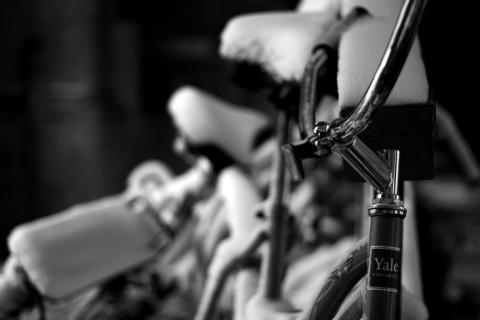 A Yale bike in the HGS courtyard - New Haven, CT. Photo by Lawrence Lee
A Yale bike in the HGS courtyard - New Haven, CT. Photo by Lawrence Lee -
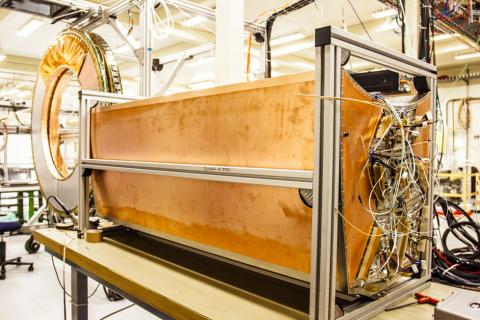 ATLAS Transition Radiation Tracker test stand during the construction phase. Prof.Tipton's group was heavily involved from the very beginning and lead the project to its completion. Photo by Andrey Loginov
ATLAS Transition Radiation Tracker test stand during the construction phase. Prof.Tipton's group was heavily involved from the very beginning and lead the project to its completion. Photo by Andrey Loginov -
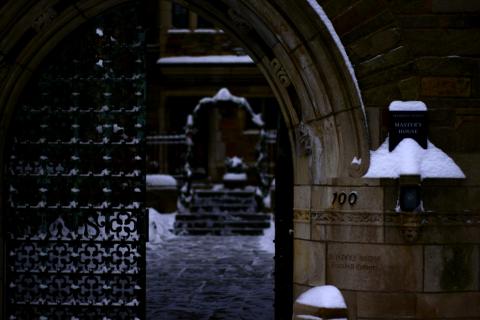 The Master's house of Trumbull College - New Haven, CT. Photo by Lawrence Lee
The Master's house of Trumbull College - New Haven, CT. Photo by Lawrence Lee -
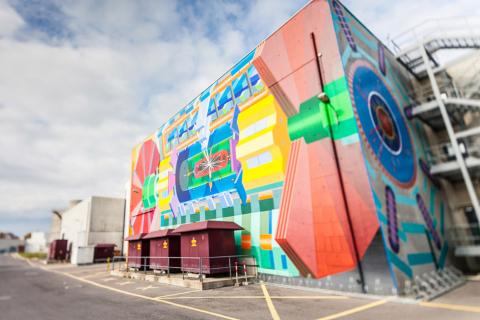 Artist's impression on the ATLAS experiment (Yale group is leading a few projects in the international collaboration). 100m underground there is the actual ATLAS detector: diameter 25m; length 46m; overall weight 7,000 tonnes; 3,000 km of cables. Photo by Andrey Loginov
Artist's impression on the ATLAS experiment (Yale group is leading a few projects in the international collaboration). 100m underground there is the actual ATLAS detector: diameter 25m; length 46m; overall weight 7,000 tonnes; 3,000 km of cables. Photo by Andrey Loginov -
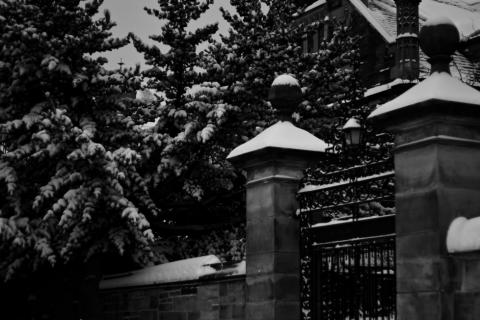 A snowy day on cross campus - New Haven, CT. Photo by Lawrence Lee
A snowy day on cross campus - New Haven, CT. Photo by Lawrence Lee -
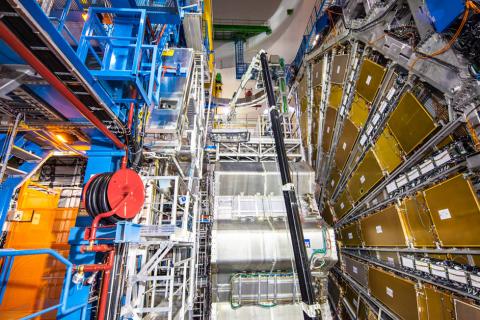 ATLAS detector underground during some final preparatory work. Photo by Andrey Loginov
ATLAS detector underground during some final preparatory work. Photo by Andrey Loginov -
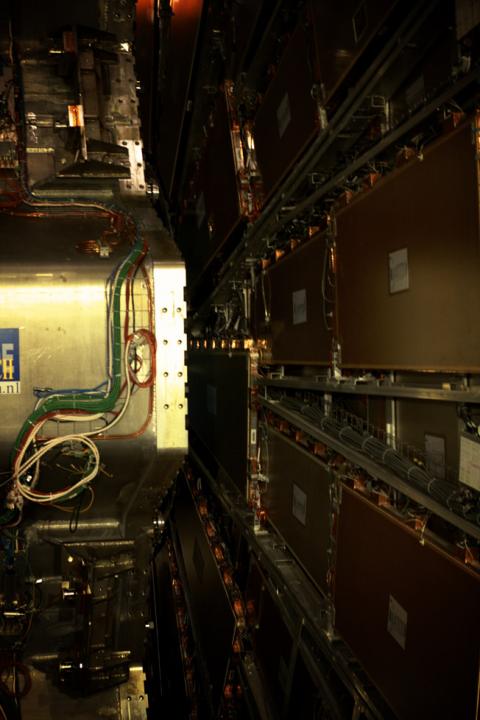 The ATLAS detector at the LHC at CERN - New Haven, CT. Photo by Lawrence Lee
The ATLAS detector at the LHC at CERN - New Haven, CT. Photo by Lawrence Lee -
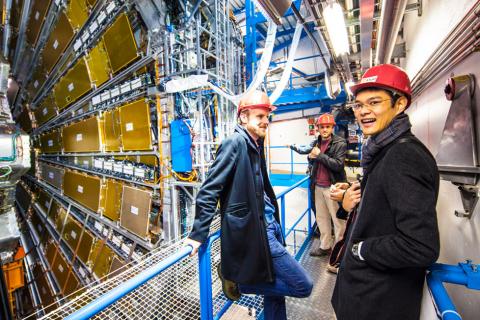 "ATLAS Yale group members (Larry Lee, Ford Garberson and Jahred Adelman) visiting the detector in early 2012. All these visitors have been playing leading roles in physics analyses of ATLAS data since the beginning of the ATLAS data-taking." Photo by Andrey Loginov
"ATLAS Yale group members (Larry Lee, Ford Garberson and Jahred Adelman) visiting the detector in early 2012. All these visitors have been playing leading roles in physics analyses of ATLAS data since the beginning of the ATLAS data-taking." Photo by Andrey Loginov -
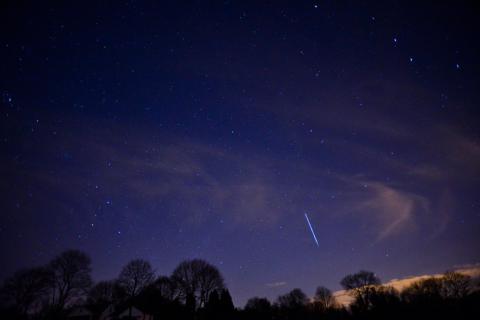 Geminids meteor shower last December just north of New Haven showing a meteor shooting across the sky. Photo by Eric Jin (2nd Place)
Geminids meteor shower last December just north of New Haven showing a meteor shooting across the sky. Photo by Eric Jin (2nd Place) -
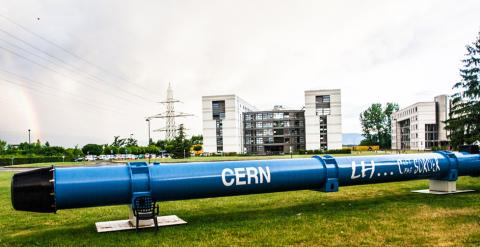 Rainy day at CERN, home for the Large Hadron Collider (LHC). One of the high-tech magnets (similar to those used in the LHC) with a caption saying something along the lines "this is not rocket science" (or "this is not magic"). Photo by Andrey Loginov
Rainy day at CERN, home for the Large Hadron Collider (LHC). One of the high-tech magnets (similar to those used in the LHC) with a caption saying something along the lines "this is not rocket science" (or "this is not magic"). Photo by Andrey Loginov -
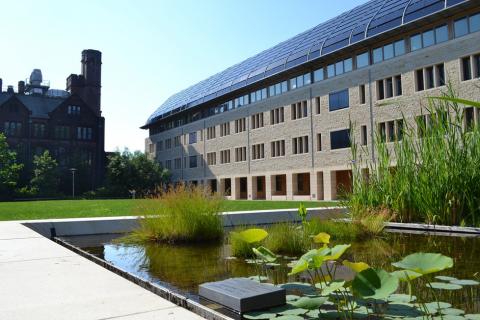 The lovely courtyard between the forestry school and chemistry buildings. I used to eat lunch here every day! Photo by Benjamin Elder
The lovely courtyard between the forestry school and chemistry buildings. I used to eat lunch here every day! Photo by Benjamin Elder -
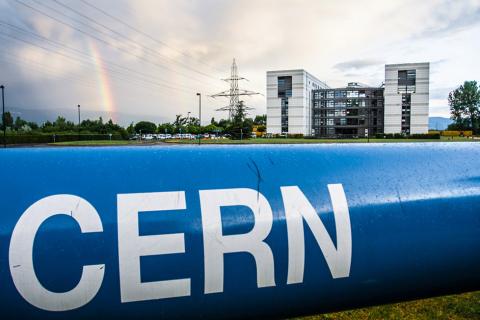 Double-rainbow-rainy-day at CERN. The photo features CERN logo on the magnet with the brainstorm (Higgs hunting team) building aka "batiment 40" (building 40) in the background. Photo by Andrey Loginov
Double-rainbow-rainy-day at CERN. The photo features CERN logo on the magnet with the brainstorm (Higgs hunting team) building aka "batiment 40" (building 40) in the background. Photo by Andrey Loginov -
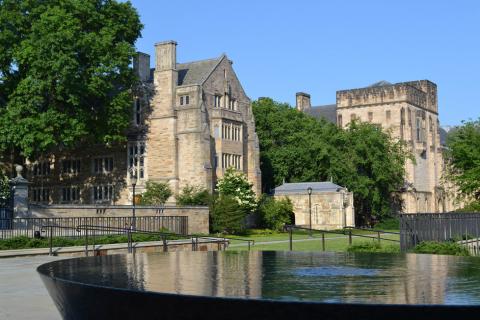 Old campus just outside the library and right before a big storm in June. Photo by Benjamin Elder
Old campus just outside the library and right before a big storm in June. Photo by Benjamin Elder -
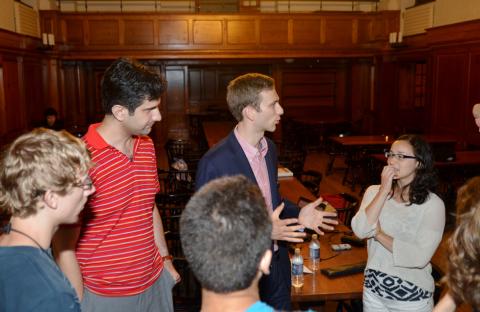 Fellows of Open Labs prepare engaging popular-science presentations on cutting edge research in their field to an audience of 100 motivated and academically promising high school students from SCHOLAR, a 3 year program. Event organized by Zlatko Minev, photo credit: Eric Jin
Fellows of Open Labs prepare engaging popular-science presentations on cutting edge research in their field to an audience of 100 motivated and academically promising high school students from SCHOLAR, a 3 year program. Event organized by Zlatko Minev, photo credit: Eric Jin -
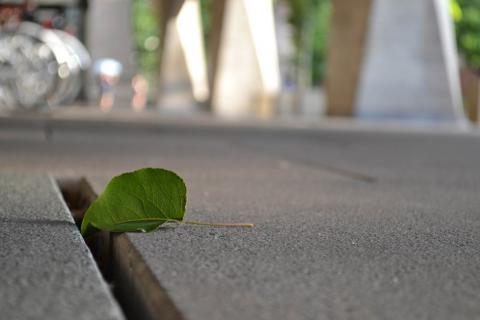 A leaf and columns, just outside Becton. Photo by Benjamin Elder
A leaf and columns, just outside Becton. Photo by Benjamin Elder -
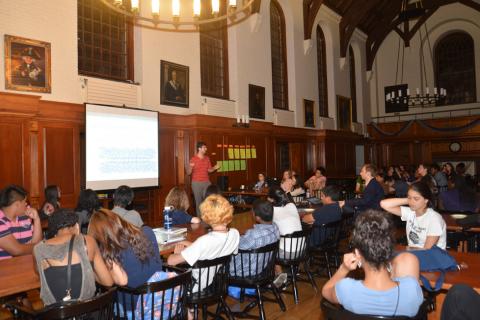 Fellows of Open Labs prepare engaging popular-science presentations on cutting edge research in their field to an audience of 100 motivated and academically promising high school students from SCHOLAR, a 3 year program. Event organized by Zlatko Minev, photo credit: Eric Jin
Fellows of Open Labs prepare engaging popular-science presentations on cutting edge research in their field to an audience of 100 motivated and academically promising high school students from SCHOLAR, a 3 year program. Event organized by Zlatko Minev, photo credit: Eric Jin -
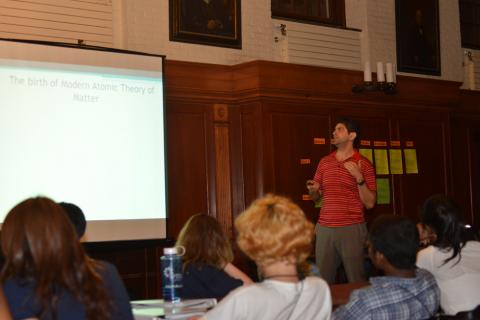 Fellows of Open Labs prepare engaging popular-science presentations on cutting edge research in their field to an audience of 100 motivated and academically promising high school students from SCHOLAR, a 3 year program. Event organized by Zlatko Minev, photo credit: Eric Jin
Fellows of Open Labs prepare engaging popular-science presentations on cutting edge research in their field to an audience of 100 motivated and academically promising high school students from SCHOLAR, a 3 year program. Event organized by Zlatko Minev, photo credit: Eric Jin -
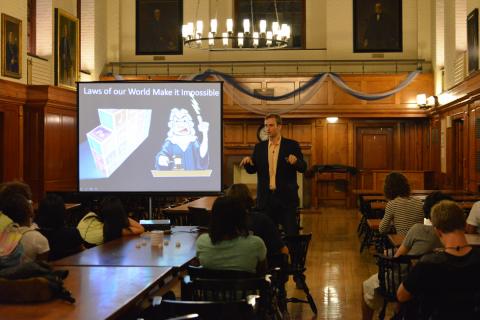 Fellows of Open Labs prepare engaging popular-science presentations on cutting edge research in their field to an audience of 100 motivated and academically promising high school students from SCHOLAR, a 3 year program. Event organized by Zlatko Minev, photo credit: Eric Jin
Fellows of Open Labs prepare engaging popular-science presentations on cutting edge research in their field to an audience of 100 motivated and academically promising high school students from SCHOLAR, a 3 year program. Event organized by Zlatko Minev, photo credit: Eric Jin -
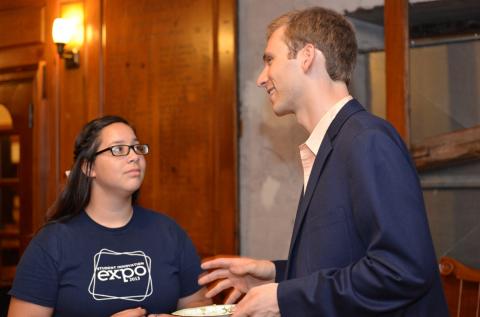 Fellows of Open Labs prepare engaging popular-science presentations on cutting edge research in their field to an audience of 100 motivated and academically promising high school students from SCHOLAR, a 3 year program. Event organized by Zlatko Minev, photo credit: Eric Jin
Fellows of Open Labs prepare engaging popular-science presentations on cutting edge research in their field to an audience of 100 motivated and academically promising high school students from SCHOLAR, a 3 year program. Event organized by Zlatko Minev, photo credit: Eric Jin
June 21, 2013
Gallery of submissions for 2013 Photo contest for new departmental web page.